

The election campaign in the United States is getting more and more tense! We provide you with all the background information on the parties and introduce you to all the important dates and the most promising candidates for the US Elections in 2024.
The US Constitution of 1787 stipulates that the people of the United States are to choose their government in free and open elections. However, at the time, not all citizens were able to participate in this democratic process.
The founding fathers of the US Constitution stipulated that only white men of the Protestant faith from the middle and upper classes were allowed to vote in the presidential election. Women, slaves, and servants, as well as Catholics and Jews, were not eligible to vote back then. The group of people entitled to vote was, therefore, relatively small and only made up around 10 % of the total population.
Over time, the right to vote in the USA was extended through various amendments. From around 1830, all adult white men were allowed to vote. The denominational and social restrictions were lifted, so that religious affiliation and property ownership no longer determined the right to vote.
After the American Civil War, the male former slaves were also given a vote in US elections through Amendment 15. Women had to wait even longer for their unrestricted right to vote, which was only added to the Constitution with Amendment 19 in 1920. In 1971, the minimum voting age was lowered from 21 to 18 years.

Since the mid-19th century, the US political landscape has been dominated by only two major parties: the Democratic Party and the Republican Party.
Founded in 1792, the Democratic Party is the longest-running political party in the world as well as the largest party in the United States, counting around 47 million registered supporters. The unofficial symbol of the Democrats is the donkey, and the unofficial party color is blue.
In their founding period, the Democrats supported racial segregation and were considered to be rather conservative. Since the beginning of the 20th century, however, they have increasingly advocated progressive reforms. Since President Roosevelt's New Deal policy in the 1930s, the party has predominantly represented socially liberal ideas.
Some key issues for the Democratic Party under incumbent President Joe Biden are:
The Republican Party is also known as the "Grand Old Party" (GOP) and is nowadays regarded as the more conservative of the two major parties in the United States. The symbol of the Republican Party is the elephant and the unofficial party color is red.
The party was founded in 1854 and, in its early days, held more liberal positions than its Democratic opponents. The Republicans were against the expansion of slavery, supported classical liberalism, and advocated economic reforms. Under the first Republican President, Abraham Lincoln, slavery was abolished in the USA in 1865.
From 1912, the Republicans shifted ideologically to the right and increasingly represented conservative values. The Republicans now win the largest number of voters among Protestant Christians and the economic middle classes from the suburbs and rural areas.
Today, the Republican Party stands for:
US elections have not always been dominated by Democrats and Republicans. In the decades before the American Civil War, some US presidents were recruited from the ranks of the Federalist Party, the Democratic-Republican Party, the National Republican Party, and the Whig Party.
However, nowadays, so-called "third parties" play a minor role in US elections. There are some larger third parties, such as the Green Party, the Libertarian Party, and the Constitution Party, as well as a number of small and regional parties.
The American presidential election has been held every four years since 1788. However, long before the actual election day, the candidates get into position and fight for their party's presidential nomination in internal party primaries.
The US election process can be broken down into the following stages:
The candidates for the office of the President of the United States announce their candidacy more than a year before the actual US elections and must first go through the Primaries. However, there are no rules laid down by the Constitution for this process.
Instead, customs have developed over the years according to which the presidential candidates of the major parties are determined in the Primaries. While an incumbent president is usually automatically nominated by his party in the primaries, all other candidates try to win the favor of the electorate in several televised debates (Primary Debates) in the months leading up to the Primaries.
The official Primaries take place from January to June of the election year. The procedure varies from state to state: some organize Primaries in public polling places where eligible voters can participate regardless of party affiliation. Other states hold private party Caucuses where only registered members of the individual parties are allowed to vote.
The highlight of the Primaries is called Super Tuesday. It takes place towards the end of February or the beginning of March and is of particular importance because a large number of states vote simultaneously on this day. On Super Tuesday on March 5th, 2024, 16 Primaries took place, including in the most populous US states of California and Texas.
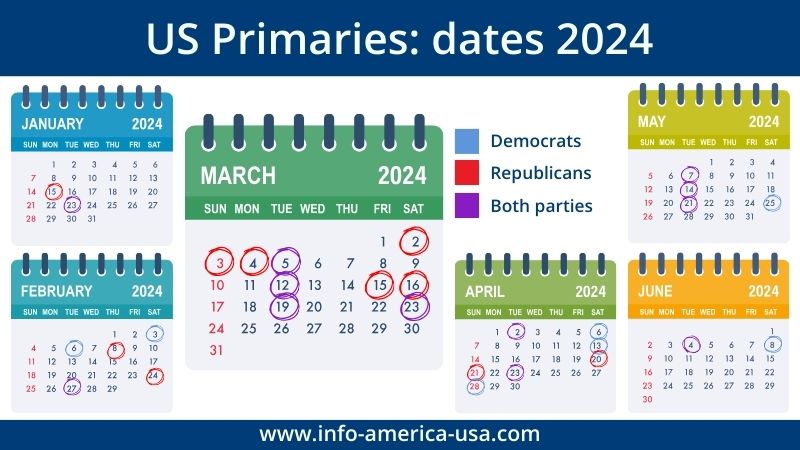
During the National Conventions, which are held over several days, the delegates chosen in the Primaries come together and cast their votes. As they are usually bound by the results of the Primaries of their state, the presidential candidate is in principle already determined in advance and is only officially announced at the National Convention.
The presidential candidates for the 2024 US election have now been announced. Donald Trump and Kamala Harris are competing for the highest political office in the United States:
Former President Donald Trump was defeated by Joe Biden in the US Elections 2020. As he only served one term in the White House, Donald Trump is able to run again in 2024. If he succeeds, he would be the second President in US history after Grover Cleveland, whose second term of office does not immediately follow the first one.
Donald Trump submitted his candidacy very early, on November 15th, 2022. He also announced that he would not run for the US Elections 2024 with former Vice President Mike Pence.
It was clear from the outset that former President Trump dominated the Republican Primaries. After Super Tuesday, he had an unassailable lead over his last remaining rival, Nikki Haley, and was the only remaining candidate from the Republican Party.
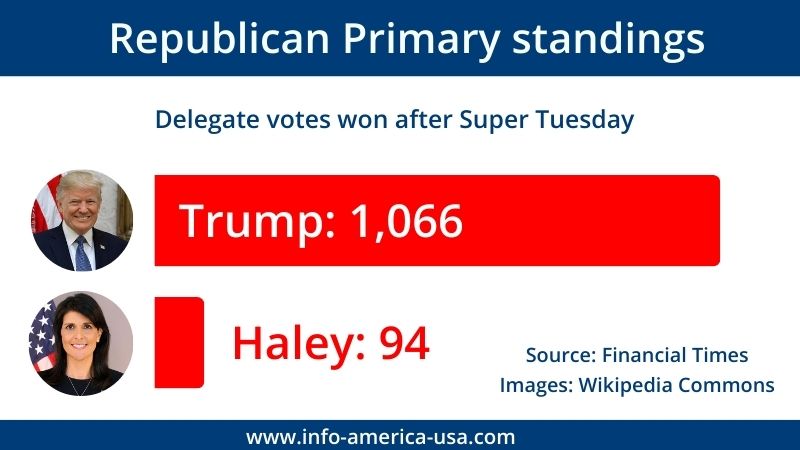
These presidential candidates from the Republican Party gave up their candidacy prematurely:
At the National Convention of the Republican Party (July 15th - 18th, 2024 in Milwaukee, Wisconsin), Donald Trump was officially confirmed as the presidential candidate. J. D. Vance, a senator from the US state of Ohio, was introduced as the “running mate” and candidate for the Vice Presidency.
An incumbent US President who has only served one term usually runs for election a second time. Also, Joe Biden announced on April 25th, 2023 that he would run again in the 2024 US elections together with Vice President Kamala Harris.
The results of the Democratic Primaries initially confirmed President Biden's candidacy. However, the persistently poor poll ratings posed a permanent challenge for the President. Approval ratings for the Biden administration's policies have been below the 50 % mark since the end of 2021. The President's age also repeatedly gave Americans cause for concern. In opinion polls, the majority of US citizens were in favor of Biden not running for a second term.
On July 21st, 2024, President Biden announced that he was ending his re-election campaign. The situation is unique: never before has an incumbent President dropped out of the presidential race so close to Election Day (107 days). Immediately after his withdrawal, President Biden announced that he would be supporting the candidacy of incumbent Vice President Kamala Harris.
Prior to the Democratic National Convention (August 19th-22nd, 2024 in Chicago, Illinois), Vice President Harris was officially confirmed as the presidential candidate for the US elections 2024. On August 6th, 2024, Harris announced that the Governor of Minnesota, Tim Walz, would enter the race for Vice President as the Democratic candidate.
Current polls suggest a close race between Vice President Harris and former President Trump:
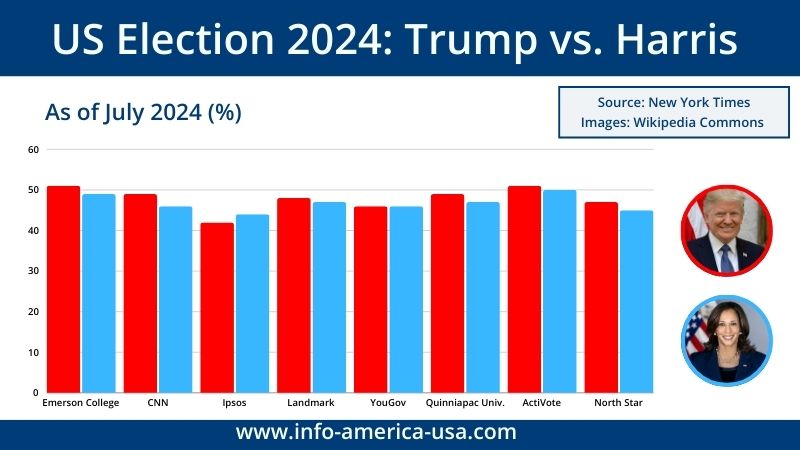
In addition to the two major parties, independent and third-party candidates have also announced their intention to run in the US Elections 2024.
Robert F. Kennedy Jr., nephew of former US President John F. Kennedy, announced his candidacy for the Democratic Party in April 2023, but decided to enter the race as an independent candidate in October 2023. He withdrew his candidacy on August 23rd, 2024.
These independent and third party candidates are still in the race:
After the presidential candidates of the individual parties have emerged during the Primaries, the actual race for the presidency begins:
Usually, the presidential candidates of both major parties meet in several televised debates, the Presidential Debates, in the weeks leading up to Election Day. The candidates for the Vice Presidency also hold a debate. In the verbal exchanges on various current issues and fundamental points of their programs, the candidates try to convince undecided voters.
The first presidential debate between Joe Biden and Donald Trump took place in Atlanta, Georgia, on June 27th, 2024 – even before the National Conventions.
It is not yet clear whether there will be any further debates. Expected dates are:
Since the middle of the 19th century, Election Day in the USA has been held on the first Tuesday in November. The US Elections 2024 will therefore take place on November 5th. The members of the House of Representatives and a third of the members of the Senate will also be chosen on the same day.
Compared to other industrialized nations in the Western world, voter turnout in the USA is relatively low. In recent decades, it has usually been between 50 % and 60 %. However, in the last Presidential Elections in 2020, voter turnout reached its highest level in more than 100 years at over 66 %.
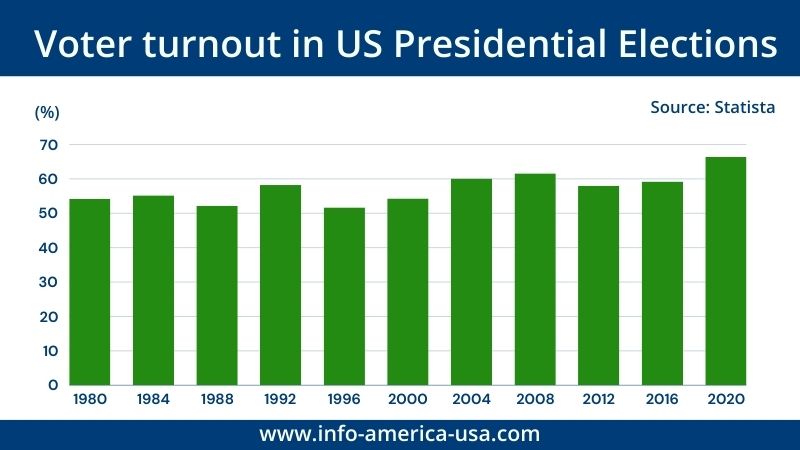
On most occasions in the past, the winner has been announced during election night. However, it can sometimes take several days before the final election decision is pronounced. This is mainly due to the different regulations in the US states regarding the counting of votes. For example, the result of the US Election 2000 between George W. Bush and Al Gore was so close and controversial that the winner was not announced until 36 days after the actual Election Day.
In some states, the election results have remained virtually unchanged for decades. In the "Red States," which are mainly located in the interior of the country, the Great Plains, and the South, Republican candidates usually have a clear majority. The West Coast and large parts of the North-East of the USA belong to the Democratic "Blue States."
The US elections are usually won by the candidate who can prevail in the so-called "Swing States," where neither party is dominant. The most important Swing States include Florida, Georgia, Pennsylvania, and Michigan.
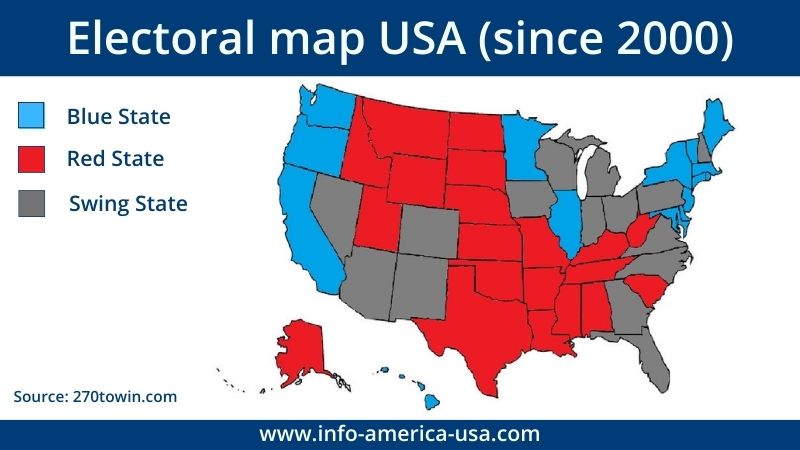
The term gerrymandering describes the shifting of electoral district boundaries in a majority voting system in order to increase one's own chances of success. This practice is repeatedly described as undemocratic because it allows politicians to choose their voters, rather than the other way around.
The word is made up of “Gerry” and “salamander.” Elbridge Gerry was governor of Massachusetts when he passed a law reorganizing the electoral districts in his state in 1812. The new borders of the electoral districts benefited his party. A contemporary newspaper cartoonist noted that one of the districts resembled a salamander.
All states in the USA are affected by gerrymandering today. However, according to data from World Population Review, the states most severely marked by gerrymandering are North Carolina, Maryland, Pennsylvania, Kentucky, Louisiana, Arkansas, Utah, Texas, Ohio, West Virginia, and Wisconsin.
Although the names of the presidential candidates will be on the ballot on November 5th, 2024, Americans do not vote for them directly. They actually vote for a body of electors associated with each candidate, also known as the Electoral College. A total of 538 men and women are appointed, with the population size of each US state determining how many electors they are allowed to send.
The Electoral College will meet on December 17th, 2024 to elect the next President on behalf of the people. The result of the US Elections 2024 will then be officially announced at the first meeting of Congress in early January of the following year.
The term of office of the new President of the United States begins on Inauguration Day. Since 1937, this has traditionally been celebrated on January 20th.
The ceremony, during which the President and Vice President swear their oaths of office, is held in front of the Capitol in Washington, D.C., and is attended by thousands of spectators. The freshly sworn-in US President then delivers his Inaugural Address, in which he outlines his plans for the coming term of office.
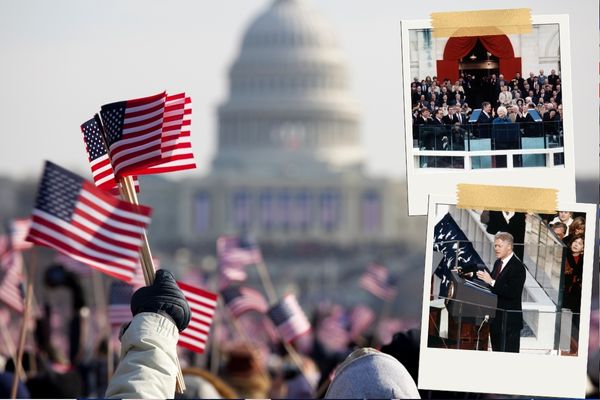
Do you have more questions about the US Elections 2024? You will certainly find the answer in our FAQ:
Presidential candidates in the USA must have US citizenship by birth ("natural born citizen"), be at least 35 years old, and have lived in the United States continuously for at least 14 years.
The 22nd Amendment to the Constitution stipulates that a US President may only serve two terms. However, it was not ratified by Congress until 1951. Before that, the two-term limit was more or less a tradition followed by most US Presidents since George Washington. Although a few presidents sought a third term, they were unsuccessful.
The only exception was Franklin D. Roosevelt, who was elected for a third term in 1940 and a fourth in 1944. The breach of the previous tradition was mainly due to the particular challenges that the USA was confronted with during the Second World War.
America's first president, George Washington, was an independent. He won the Presidential Election of 1788/89 against the Federalist candidate John Adams.
US citizens who are at least 18 years old and who can prove a current or former residence in one of the 50 US states or Washington, D.C., are eligible to vote in the Presidential Elections.
Green Card holders are not eligible to vote in the US Elections 2024. The same applies to people from the US foreign territories, e.g., the US Virgin Islands, Guam, or Puerto Rico. Furthermore, prison inmates are not allowed to vote.
The main reason for the relatively low voter turnout in the USA is the complicated registration process. As there is no central register or registration office in the United States, eligible voters must register to vote in advance.
Each US state has its own regulations and procedures for registering voters, some of which are relatively complicated and have led to the exclusion of certain population groups in the past. The regulations on postal voting also differ from state to state.
The term Popular Vote refers to the total number of votes cast for candidates by the electorate throughout the country. However, the result of the Popular Vote is not always identical to the official outcome of the elections. Due to the Electoral College system in the USA, the candidate who gets the most votes nationwide – i.e. who wins the Popular Vote – does not always become President.
For example, Hillary Clinton received around 2.9 million more votes than Donald Trump in the US Elections 2016. Despite winning the Popular Vote, she lost the presidential race because Trump was able to secure more votes in the Electoral College.
Win one of 55,000 Green Cards in the official Green Card Lottery of the US authorities!